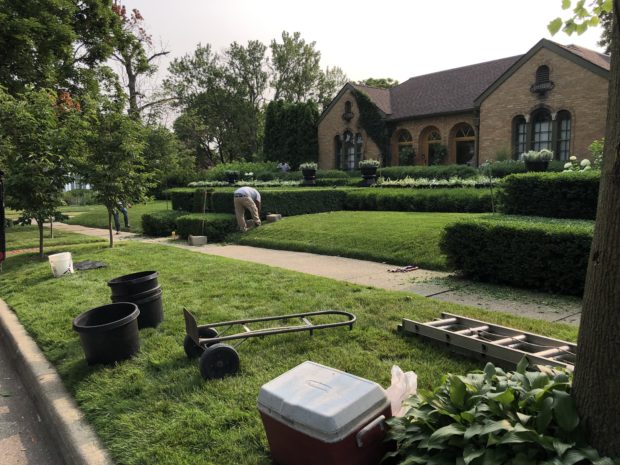 The day that Melissa and her crew comes to prune my boxwood is my favorite day of the gardening year. First and foremost, their pruning is extraordinarily true and square. So precise. It takes a while to set up all of the level lines that will serve at a cutting guide. But beyond the string lines is a skill that is astonishing to watch. The coordination between the eye, and a heavy pair of shears held either horizontally or vertically takes strength, patience, experience, and talent. Loads of talent. I so admire their skill, concentration and resolve. Pruning my boxwood takes the better part of a day.
The day that Melissa and her crew comes to prune my boxwood is my favorite day of the gardening year. First and foremost, their pruning is extraordinarily true and square. So precise. It takes a while to set up all of the level lines that will serve at a cutting guide. But beyond the string lines is a skill that is astonishing to watch. The coordination between the eye, and a heavy pair of shears held either horizontally or vertically takes strength, patience, experience, and talent. Loads of talent. I so admire their skill, concentration and resolve. Pruning my boxwood takes the better part of a day.
 Secondly, that pruning is a natural extension of the intent of the design. The pleasure I derive from my primarily evergreen landscape is a simple one. I like what weather does to the landscape. Weather acting on the landscape changes the look and experience of it, day after day. The sunny days create shadows that highlight the forms. Overcast days emphasize the contrast of the leaf texture with the volume and mass of the shapes. The random leaves falling from the trees in October provide as much fresh interest as a dusting of new snow. Rain makes all of the evergreen surfaces sparkle.
Secondly, that pruning is a natural extension of the intent of the design. The pleasure I derive from my primarily evergreen landscape is a simple one. I like what weather does to the landscape. Weather acting on the landscape changes the look and experience of it, day after day. The sunny days create shadows that highlight the forms. Overcast days emphasize the contrast of the leaf texture with the volume and mass of the shapes. The random leaves falling from the trees in October provide as much fresh interest as a dusting of new snow. Rain makes all of the evergreen surfaces sparkle.
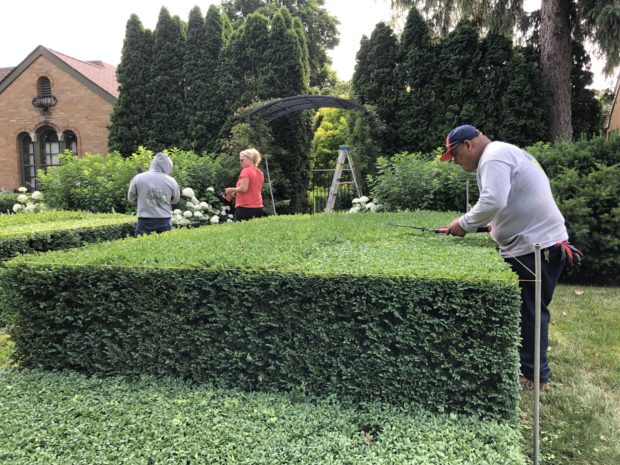 The boxwood is the most formal element of the landscape, as both the placement and pruning is formal. That hand pruning makes all of the forms clear. That snip snip snip goes on all day long. The sound is regular, and musical. The painstakingly trimmed boxwood is a beautiful contrast to the big wild growing hydrangeas. Boxwood left to its own devices has a beautiful and gently shaggy appearance. That look can work well in a variety of circumstances. But I favor a look that is orderly and defined. I find that clean crisp look relaxing. It is the feeling I want, when I am in the garden.
The boxwood is the most formal element of the landscape, as both the placement and pruning is formal. That hand pruning makes all of the forms clear. That snip snip snip goes on all day long. The sound is regular, and musical. The painstakingly trimmed boxwood is a beautiful contrast to the big wild growing hydrangeas. Boxwood left to its own devices has a beautiful and gently shaggy appearance. That look can work well in a variety of circumstances. But I favor a look that is orderly and defined. I find that clean crisp look relaxing. It is the feeling I want, when I am in the garden.
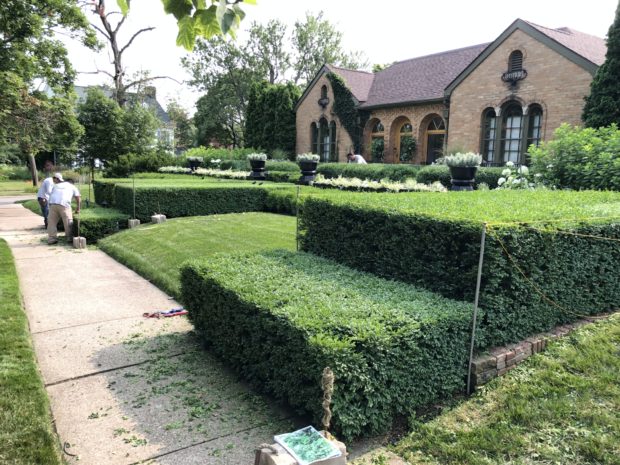 Melissa and her crew take what I have taken great pains to grow, and prune them into distinct shapes. It is amazing how much they grow out in a year’s time. The pruning timing can be tricky. I do not like to prune before the spring flush is finished. Pruning too early means it will take another round later on to keep them neat. So later in June, in my zone. I also like to prune before the weather gets too hot. Pruning on a 90 degree day will insure that the tender growth underneath that has been completely shaded will burn in the blazing hot sun. Pruning is a call to grow, so I try not to prune later in the season. Evergreen plants should begin the shutting down process in August, so when the winter comes, they are completely dormant.
Melissa and her crew take what I have taken great pains to grow, and prune them into distinct shapes. It is amazing how much they grow out in a year’s time. The pruning timing can be tricky. I do not like to prune before the spring flush is finished. Pruning too early means it will take another round later on to keep them neat. So later in June, in my zone. I also like to prune before the weather gets too hot. Pruning on a 90 degree day will insure that the tender growth underneath that has been completely shaded will burn in the blazing hot sun. Pruning is a call to grow, so I try not to prune later in the season. Evergreen plants should begin the shutting down process in August, so when the winter comes, they are completely dormant.
 Most of these boxwood are better than 20 years old. Clearly they cheerfully tolerate this type of pruning. Not all evergreens like this. Yews especially can die out on the interior if they are pruned into densely formal shapes. They need some air and light to penetrate to the interior. All of the spreading yews on my property have a natural look to them, for exactly that reason. A healthy plant is a beautiful plant. If I am looking for a hedging yew with a formal shape, I choose a cultivar that grows that way, naturally. Taxus media “Mooni” is a formal grower, and rarely needs much pruning to keep it in shape.
Most of these boxwood are better than 20 years old. Clearly they cheerfully tolerate this type of pruning. Not all evergreens like this. Yews especially can die out on the interior if they are pruned into densely formal shapes. They need some air and light to penetrate to the interior. All of the spreading yews on my property have a natural look to them, for exactly that reason. A healthy plant is a beautiful plant. If I am looking for a hedging yew with a formal shape, I choose a cultivar that grows that way, naturally. Taxus media “Mooni” is a formal grower, and rarely needs much pruning to keep it in shape.
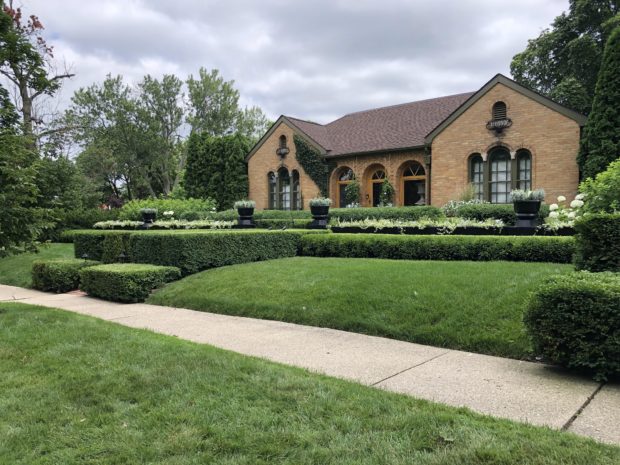 At days end, I still like the composition decades old. And I know that, as Henry Mitchell once wrote, great gardens are the result of the intensive care of the present. The care my landscape gets might easily be more important than the design. Well cared for is always a good look. Mow the grass, pull the weeds, and prune the shrubs.
At days end, I still like the composition decades old. And I know that, as Henry Mitchell once wrote, great gardens are the result of the intensive care of the present. The care my landscape gets might easily be more important than the design. Well cared for is always a good look. Mow the grass, pull the weeds, and prune the shrubs.
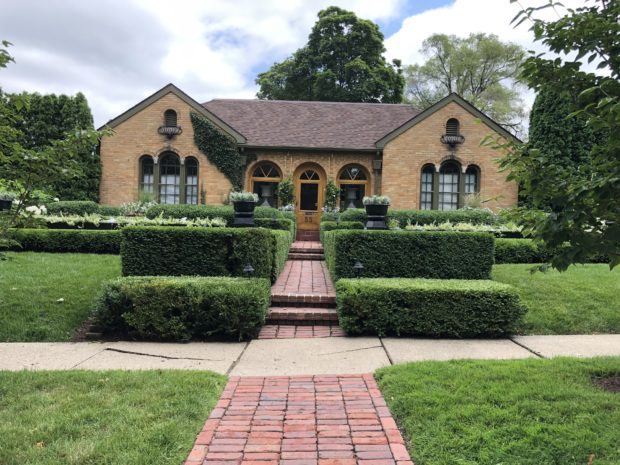 I drive Milo and I here every day after work. For several years now, I have parked in front, and ushered my dogs up the front steps. Howard needed help going up even a single step. This was the easiest way in for him. I could lift him over the two sets of two steps. He passed away in late May, but Milo and I still enjoy coming home, and walking up to the front door. How this looks after the trim makes me happy to come home.
I drive Milo and I here every day after work. For several years now, I have parked in front, and ushered my dogs up the front steps. Howard needed help going up even a single step. This was the easiest way in for him. I could lift him over the two sets of two steps. He passed away in late May, but Milo and I still enjoy coming home, and walking up to the front door. How this looks after the trim makes me happy to come home.
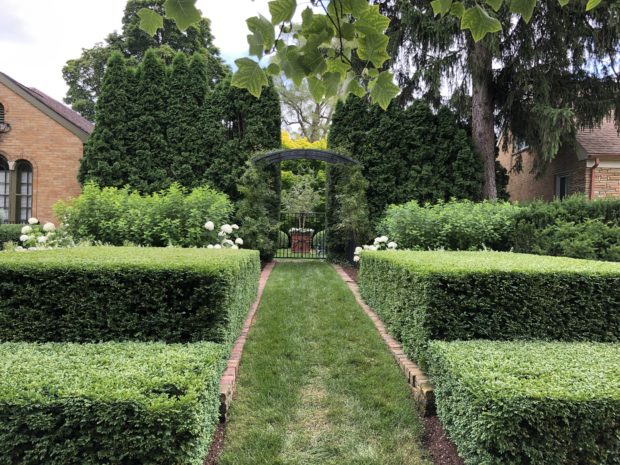 I do have a secondary entrance to the side garden. Trimmed boxwood hugs the grass ramp up. The design here makes much of the foreground boxwood, the midground hydrangeas, and the far ground container in the side yard. In the background is a glimpse of the Princeton Gold maple trees. This is a good summer look, but it looks good no matter the season. And no matter the weather.
I do have a secondary entrance to the side garden. Trimmed boxwood hugs the grass ramp up. The design here makes much of the foreground boxwood, the midground hydrangeas, and the far ground container in the side yard. In the background is a glimpse of the Princeton Gold maple trees. This is a good summer look, but it looks good no matter the season. And no matter the weather.
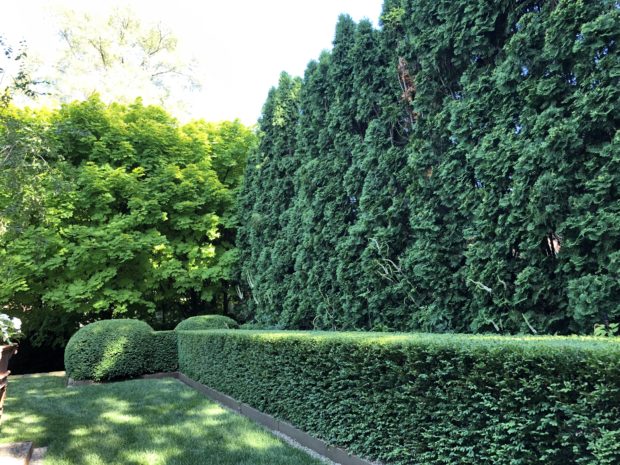 The side yard boxwood is accompanied by an old hedge of thuja nigra, and a stand of Princeton Gold maple trees to the east on the lower level. I like all of the green. From the trees down to the grass. Peaceful, this.
The side yard boxwood is accompanied by an old hedge of thuja nigra, and a stand of Princeton Gold maple trees to the east on the lower level. I like all of the green. From the trees down to the grass. Peaceful, this.
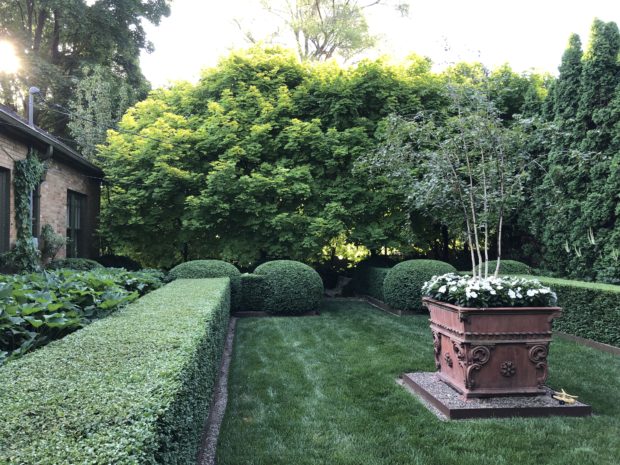 These side yard boxwoods are at least 20 years old. All trimmed up, they do my head, heart and eye a world of good. The edger strip enclosing the gravel at their base has been in long enough to go wobbly. But the boxwood is as level straight and true as can be.
These side yard boxwoods are at least 20 years old. All trimmed up, they do my head, heart and eye a world of good. The edger strip enclosing the gravel at their base has been in long enough to go wobbly. But the boxwood is as level straight and true as can be.
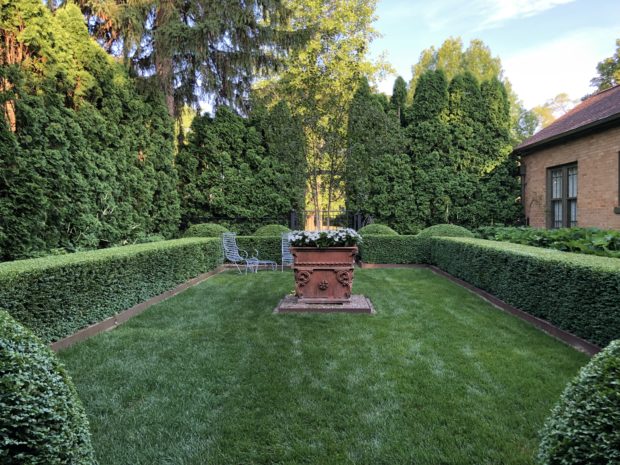 Buck, Milo and I come up here every night to talk over the news of the day. This years news? The boxwood has grown out enough to be flush with the raised steel edger strip. It has taken many years to get to this point, but I am loving the look. The big idea? Those simple pleasures in a landscape can mean so much. Simple is good for the three of us. Well maintained makes every garden maker feel better.
Buck, Milo and I come up here every night to talk over the news of the day. This years news? The boxwood has grown out enough to be flush with the raised steel edger strip. It has taken many years to get to this point, but I am loving the look. The big idea? Those simple pleasures in a landscape can mean so much. Simple is good for the three of us. Well maintained makes every garden maker feel better.
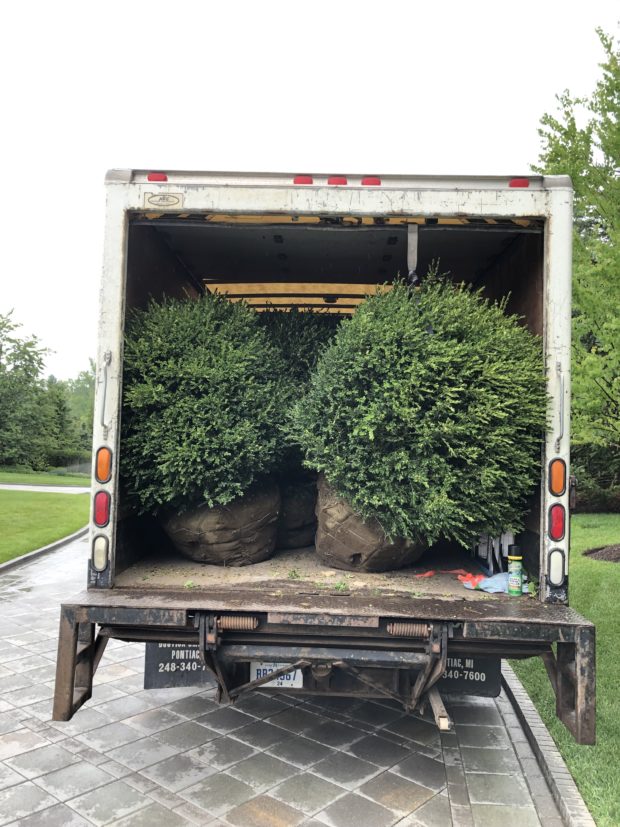 As a designer, I take a good bit of time trying to find out what clients want from their landscapes. That is key to providing them a good design. This client has some big boxwood in her future.
As a designer, I take a good bit of time trying to find out what clients want from their landscapes. That is key to providing them a good design. This client has some big boxwood in her future.
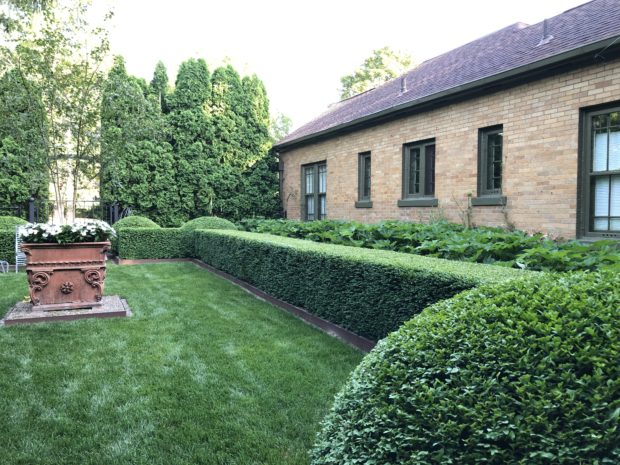
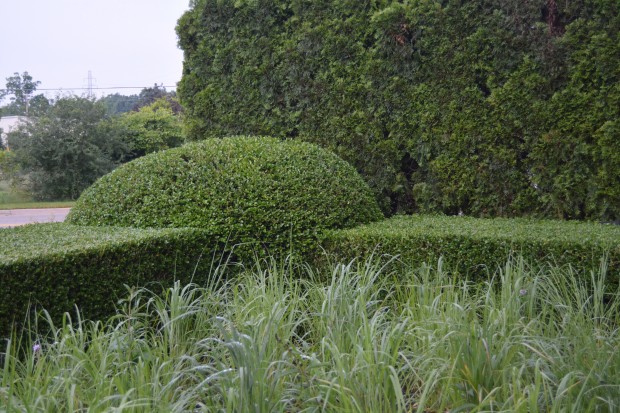
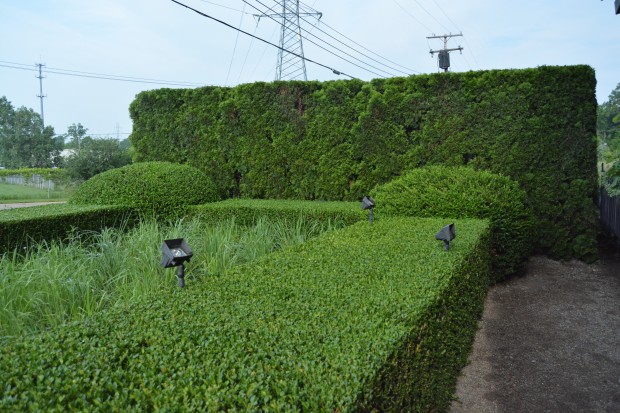

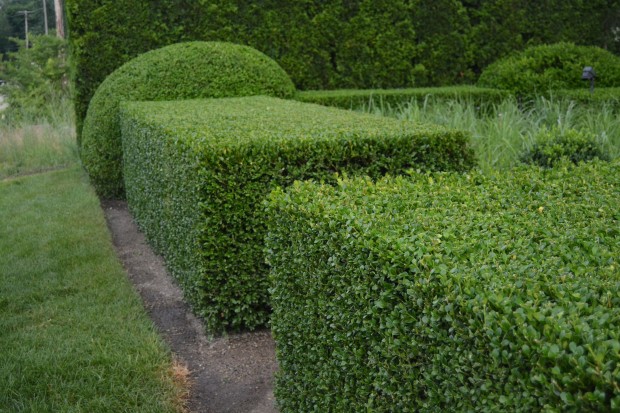
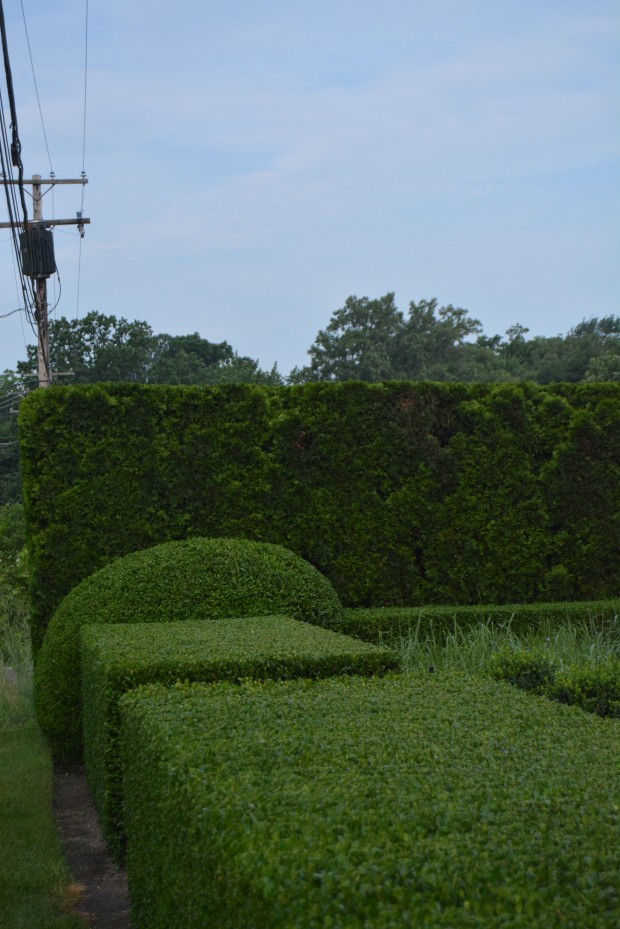
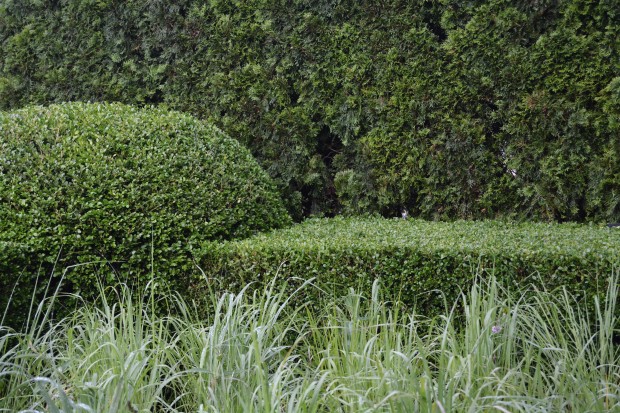
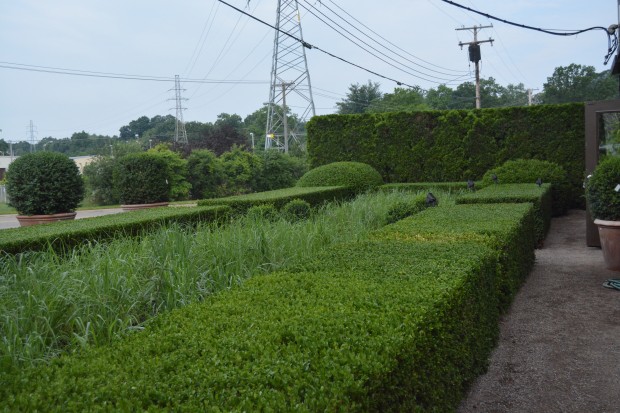
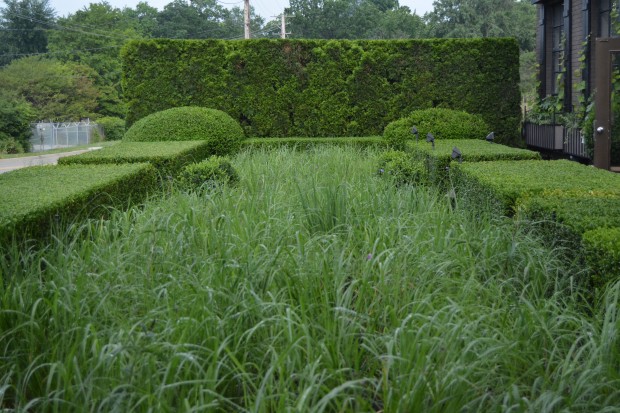
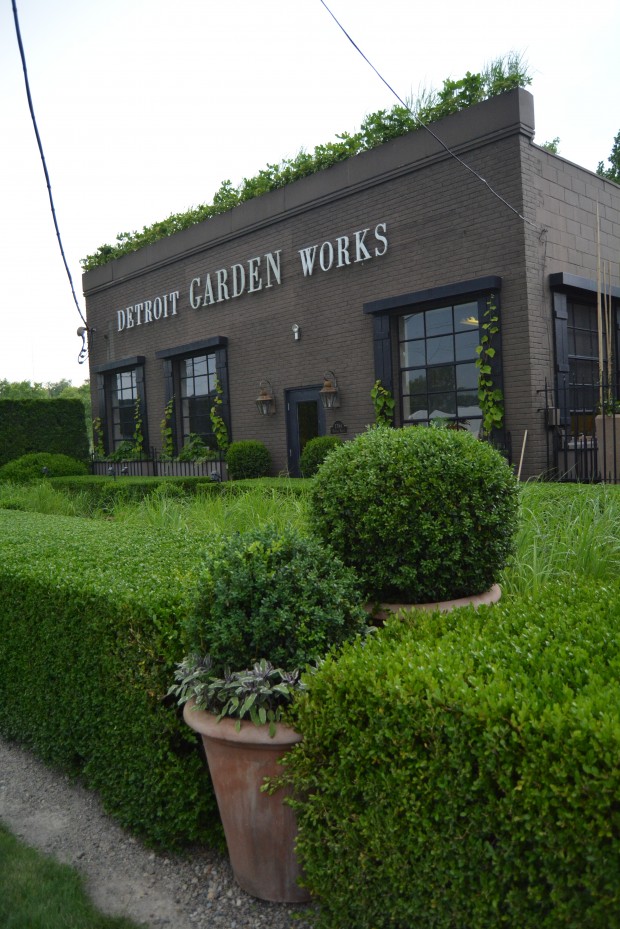 We lost 2 boxwood in the hedge over this past winter. We did have one replacement available. In this spot, we went another direction. We stitched the hedge back together, with a pair of potted boxwoods.
We lost 2 boxwood in the hedge over this past winter. We did have one replacement available. In this spot, we went another direction. We stitched the hedge back together, with a pair of potted boxwoods.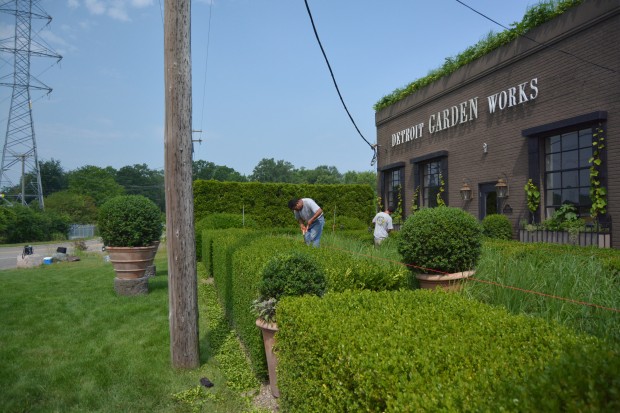
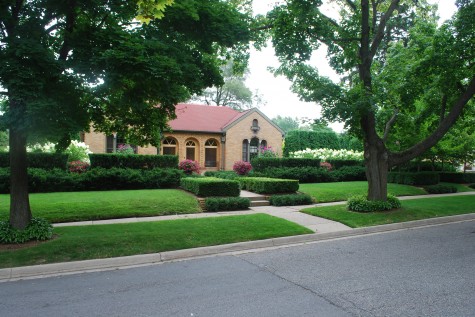
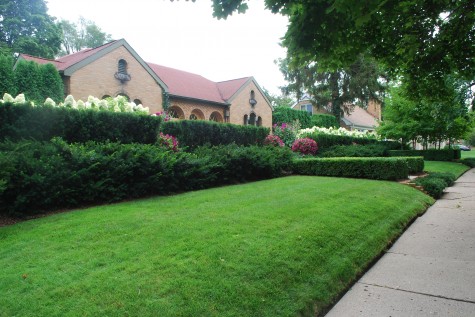 For the better part of six years I did nothing to this yard except bark the existing perennial beds, and mow the grass. It took all my energy to handle my work-or so it seemed. I am embarrassed to say that somewhere along the line I got an anonymous postcard in the mail: “It is hard to believe that a person whose career is landscape would have weeds six feet tall in her front yard”. No matter the delivery, the person had a point.
For the better part of six years I did nothing to this yard except bark the existing perennial beds, and mow the grass. It took all my energy to handle my work-or so it seemed. I am embarrassed to say that somewhere along the line I got an anonymous postcard in the mail: “It is hard to believe that a person whose career is landscape would have weeds six feet tall in her front yard”. No matter the delivery, the person had a point. But perhaps even more importantly, I was ignoring the fact that whatever I did at home would need time to come of age-and that perhaps I would want to still be around to see that. Planning my own landscape was agonizingly slow. I had no problem designing for others; I was a wreck designing for myself. Slow turned out to be fine; who can do everything at once anyway? Getting started-that was the key.
But perhaps even more importantly, I was ignoring the fact that whatever I did at home would need time to come of age-and that perhaps I would want to still be around to see that. Planning my own landscape was agonizingly slow. I had no problem designing for others; I was a wreck designing for myself. Slow turned out to be fine; who can do everything at once anyway? Getting started-that was the key.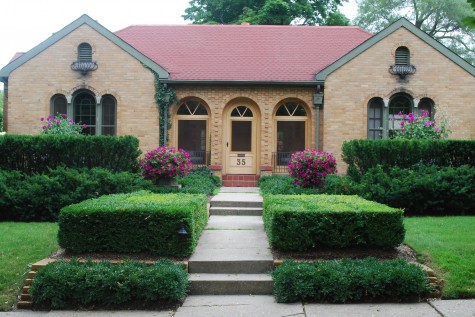 The one hundred Hicks yews across the west and down the north side came first. Given the slope of my property from the south to the north, time would prove to be an essential element. The hedge is 4 feet tall on the south side, and nine feet tall on the north side-but every one of them is level with the horizon. This hedge took eight years to grow in.
The one hundred Hicks yews across the west and down the north side came first. Given the slope of my property from the south to the north, time would prove to be an essential element. The hedge is 4 feet tall on the south side, and nine feet tall on the north side-but every one of them is level with the horizon. This hedge took eight years to grow in.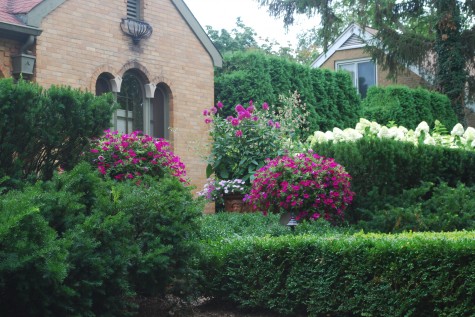 The boxwood was even slower growing; the 18″-24″ plants I put in the ground were already seven years old when I planted them. The shaggy densiformis yews are the newest evergreen addition; they have only been in four years. I like all this evergreen; I can successfully maintain it. I knew I could never devote the time needed to a big perennial garden-why come home and be frustrated about what isn’t done? Two giant blocks of Limelight hydrangeas, and 6 pots of flowers give me perennial garden pleasure, in a manageable form.
The boxwood was even slower growing; the 18″-24″ plants I put in the ground were already seven years old when I planted them. The shaggy densiformis yews are the newest evergreen addition; they have only been in four years. I like all this evergreen; I can successfully maintain it. I knew I could never devote the time needed to a big perennial garden-why come home and be frustrated about what isn’t done? Two giant blocks of Limelight hydrangeas, and 6 pots of flowers give me perennial garden pleasure, in a manageable form.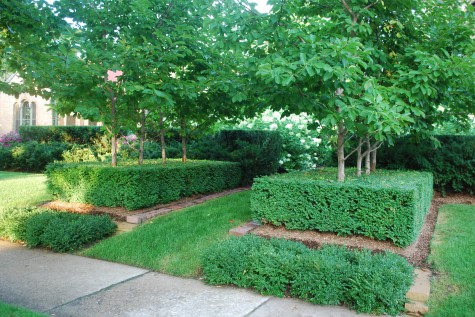 I planted this city-mini allee of Yellow Butterflies magnolias for Buck-he loves yellow. The boxwood is a big evergreen groundcover. The petals falling on this boxwood is one of my garden’s best spring moments. The mini-boxwood strips in the foreground-this year’s landscape project. The slope of the ground here made it difficult to mow the grass. The magnolias have grown considerably, and the shade they cast was not optimal for lawn. Wall stone behind them retains the soil, and in a few years, will be invisible.
I planted this city-mini allee of Yellow Butterflies magnolias for Buck-he loves yellow. The boxwood is a big evergreen groundcover. The petals falling on this boxwood is one of my garden’s best spring moments. The mini-boxwood strips in the foreground-this year’s landscape project. The slope of the ground here made it difficult to mow the grass. The magnolias have grown considerably, and the shade they cast was not optimal for lawn. Wall stone behind them retains the soil, and in a few years, will be invisible.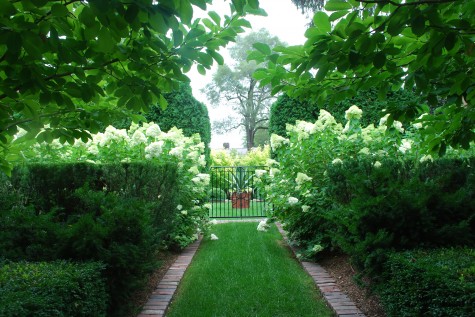 The magnolias were planted to frame the view to the side yard. It is hard arrange a long view on a city lot, making visual use of the neighbor’s mature elm adds much to the illusion of distance.
The magnolias were planted to frame the view to the side yard. It is hard arrange a long view on a city lot, making visual use of the neighbor’s mature elm adds much to the illusion of distance.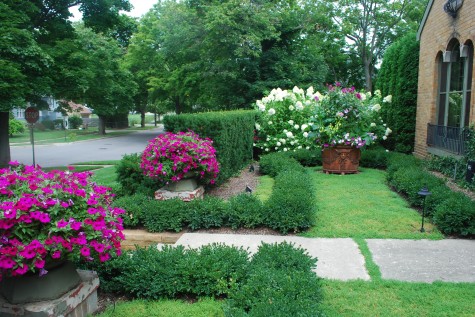 The big Yew hedge divides my public landscape, from the house landscape. The big pots are centered in front of big panels of windows; I have good views from inside. The ground is carpeted with herniaria glabra-rupturewort. This plant grows like thyme, but is much more water tolerant.
The big Yew hedge divides my public landscape, from the house landscape. The big pots are centered in front of big panels of windows; I have good views from inside. The ground is carpeted with herniaria glabra-rupturewort. This plant grows like thyme, but is much more water tolerant.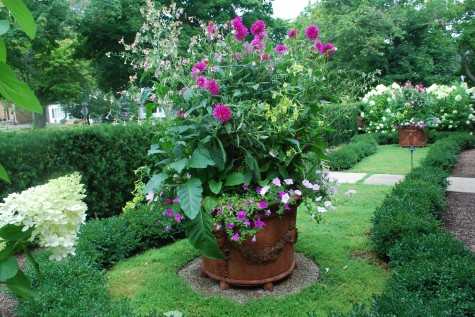

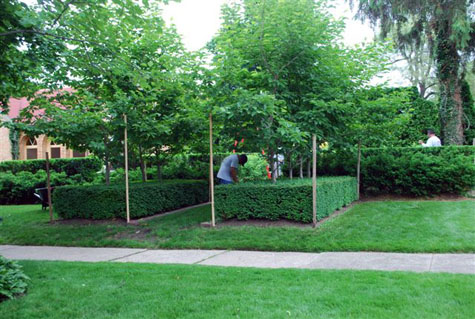 The ability to prune with true precision is as much about a gift, as it is about the science. The big science concept has to do with being able to establish a line level with the horizon, or perfectly horizontal-and its complementary-those lines exactly perpendicular to the horizon-or vertical. Mindy’s crew sets lots of vertical markers-the stakes in this pictures. They use a level to set those stakes exactly vertical.
The ability to prune with true precision is as much about a gift, as it is about the science. The big science concept has to do with being able to establish a line level with the horizon, or perfectly horizontal-and its complementary-those lines exactly perpendicular to the horizon-or vertical. Mindy’s crew sets lots of vertical markers-the stakes in this pictures. They use a level to set those stakes exactly vertical.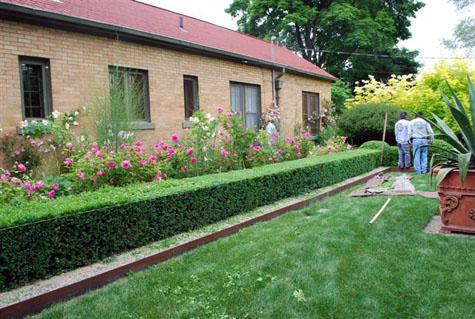 The horizontal plane is determined with a set of lines, or strings. There will be strings everywhere, side to side. But there is plenty of gift involved here too. I perfectly understand the math, but I cannot do this how they do it. Every cut is made with giant, long handled shears-by hand. The clip clip takes 7 people, an entire day; its a slow but sure process that I enjoy watching. Even the sound of the clip clip takes my blood pressure down at least 10 points.
The horizontal plane is determined with a set of lines, or strings. There will be strings everywhere, side to side. But there is plenty of gift involved here too. I perfectly understand the math, but I cannot do this how they do it. Every cut is made with giant, long handled shears-by hand. The clip clip takes 7 people, an entire day; its a slow but sure process that I enjoy watching. Even the sound of the clip clip takes my blood pressure down at least 10 points.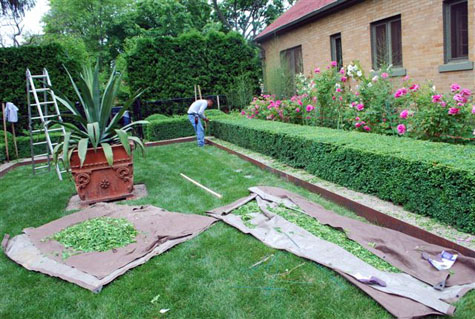 Shape, mass, and volume are very important design elements in landscape. This landscape is entirely geared to the shape, and level of the lawn plane. Every other element has been established, based on that plane. The importance of the lawn plane is accentuated by the wide, overscaled steel edger strip. Where beds and lawn are on the same plane, the edger is invisible; its function is to keep grass out of the planting beds. In this case, the edging is a design element, clearly indicating a change of level. This very geometric change of level provides lots of interest in a very small space. The boxwood pruned into long precise rectangles is a great foil to the sprawling shapes of the roses and perennials.
Shape, mass, and volume are very important design elements in landscape. This landscape is entirely geared to the shape, and level of the lawn plane. Every other element has been established, based on that plane. The importance of the lawn plane is accentuated by the wide, overscaled steel edger strip. Where beds and lawn are on the same plane, the edger is invisible; its function is to keep grass out of the planting beds. In this case, the edging is a design element, clearly indicating a change of level. This very geometric change of level provides lots of interest in a very small space. The boxwood pruned into long precise rectangles is a great foil to the sprawling shapes of the roses and perennials.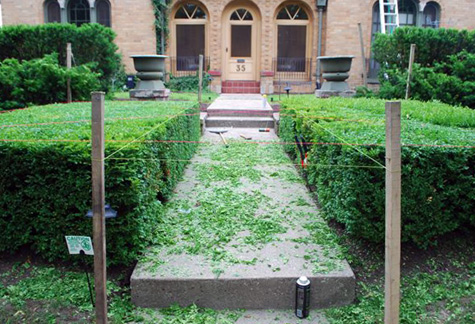 Pruning level with the horizon requires attention to a form that may not exist in the space. The land into which this landscape is planted falls from north to south, and it falls from east to west. To give you an idea of how much drop there is from the south to the north, I measured the height of my Hicks yews. On the southern most end, they are four feet tall, give or take. At the east end of the north side, they are nine feet tall; this is a lot of drop. It was many years, growing those north end yews tall enough to prune. This boxwood is pruned level with the horizon. Pruning with the lay of the land produces an entirely different effect. Level with the horizon gives a landscape a formal and serene aura. As in, on even keel, or level-headed. As my work life is as I have described a big fluid situation, I like the even keel feeling when I am in my garden. This is a choice any gardener makes when designing. What do you want from your space?
Pruning level with the horizon requires attention to a form that may not exist in the space. The land into which this landscape is planted falls from north to south, and it falls from east to west. To give you an idea of how much drop there is from the south to the north, I measured the height of my Hicks yews. On the southern most end, they are four feet tall, give or take. At the east end of the north side, they are nine feet tall; this is a lot of drop. It was many years, growing those north end yews tall enough to prune. This boxwood is pruned level with the horizon. Pruning with the lay of the land produces an entirely different effect. Level with the horizon gives a landscape a formal and serene aura. As in, on even keel, or level-headed. As my work life is as I have described a big fluid situation, I like the even keel feeling when I am in my garden. This is a choice any gardener makes when designing. What do you want from your space?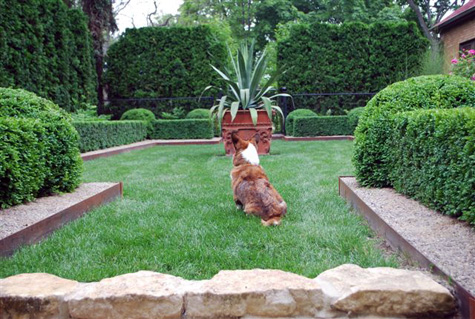 This is my idea of a good place to be.
This is my idea of a good place to be.